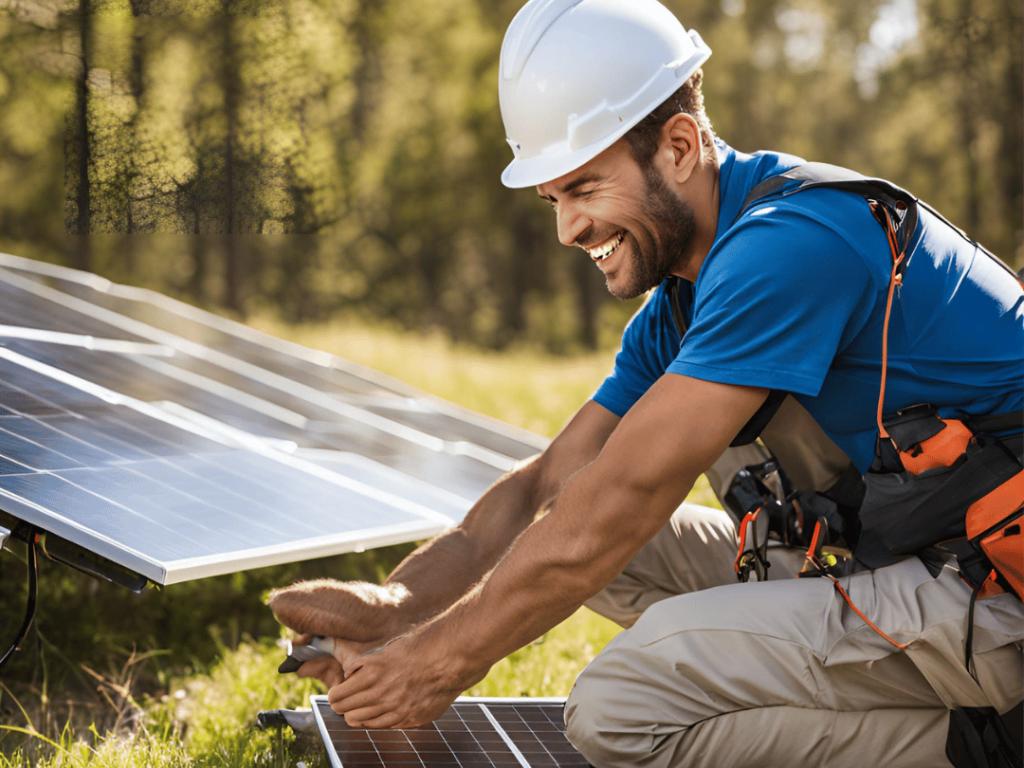
Imagine waking up in your tent, surrounded by nature, and having all the power you need at your fingertips. Sounds like a dream, right? Well, it’s time to make that dream a reality! Did you know that the global camping equipment market is expected to reach $46.7 billion by 2026? That’s huge! And with more campers going green, solar panel systems are becoming the must-have accessory for outdoor enthusiasts. In this guide, I’ll walk you through everything you need to know about setting up a for your campsite. Get ready to harness the power of the sun and take your camping game to the next level!
Understanding How to Set Up a Solar Panel System for Camping
Before we dive into the nitty-gritty of setting up your solar panel system, let’s cover the basics. Understanding the components and benefits of how to setup a solar panel system will help you make informed decisions when it’s time to purchase and install your system.
CLICK TO KOW THE EASY STEPS YOU CAN MAINTAIN YOUR SOLAR GADGETS
Components of a Camping Solar Panel System
A typical camping solar panel system consists of the following components:
- Solar panels: These capture sunlight and convert it into electricity.
- Charge controller: Regulates the voltage and current coming from the solar panels to the battery.
- Battery: Stores the electricity generated by the solar panels for later use.
- Inverter: Converts the DC power stored in the battery to AC power for use with standard electrical devices.
- Cables and connectors: Connect all the components together.
- Mounting hardware: Secures the solar panels in place.
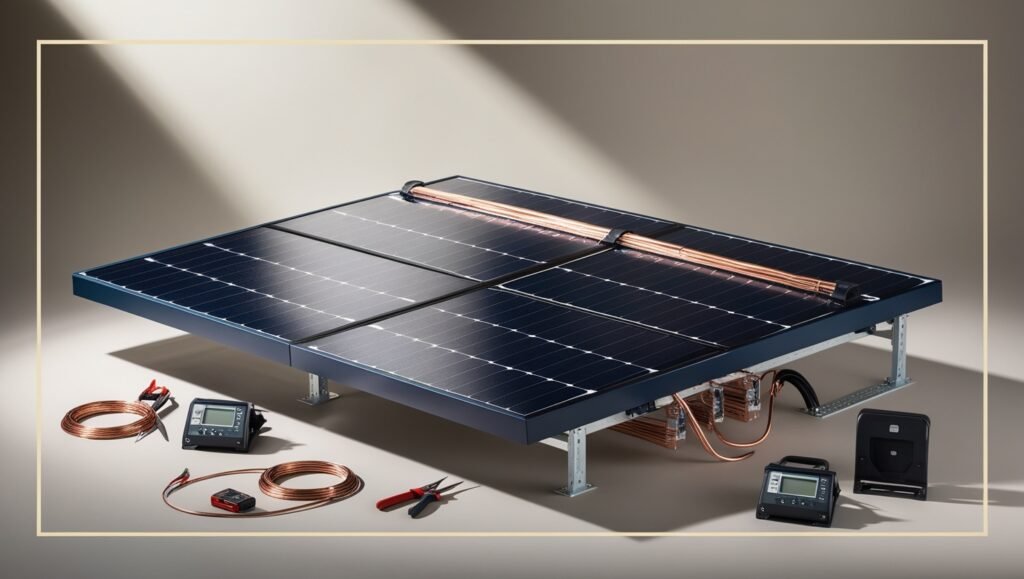
Types of Solar Panels Suitable for Camping
When it comes to camping, you’ll typically encounter two main types of solar panels:
- Monocrystalline panels: These are more efficient and perform better in low-light conditions, but they’re also more expensive.
- Polycrystalline panels: Less efficient than monocrystalline, but more affordable and still a good option for many campers.
Benefits of Using Solar Power at Your Campsite
Incorporating solar power into your camping setup offers numerous advantages:
- Eco-friendly: Harness clean, renewable energy and reduce your carbon footprint.
- Silent operation: Unlike gas generators, solar panels work silently, preserving the peace of nature.
- Low maintenance: Once set up, in the optimal solar positioning, solar panels require minimal upkeep.
- Cost-effective in the long run: After the initial investment, you’ll save money on fuel and batteries.
- Versatility: Power everything from smartphones to mini-fridges, depending on your setup.
Common Misconceptions about Camping Solar Setups
Let’s debunk some myths:
- “Solar panels don’t work on cloudy days”: While efficiency is reduced, solar panels still generate some power on overcast days.
- “Solar setups are too complicated”: With the right guidance (like this article!), anyone can set up and use a camping solar system.
- “Solar power is too expensive”: While there’s an upfront cost, solar systems can save money over time compared to disposable batteries or gas generators.
Assessing Your Power Needs
Before you start shopping for solar equipment, it’s crucial to understand your power requirements. This will help you choose a system that’s neither underpowered nor unnecessarily large and expensive.
Calculating Your Campsite’s Energy Requirements
To determine your energy needs:
- List all the devices you plan to power.
- Find the wattage for each device (usually listed on the device or in its manual).
- Estimate how many hours per day you’ll use each device.
- Multiply the wattage by the hours of use to get watt-hours (Wh) per day for each device.
- Add up all the watt-hours to get your total daily energy requirement.
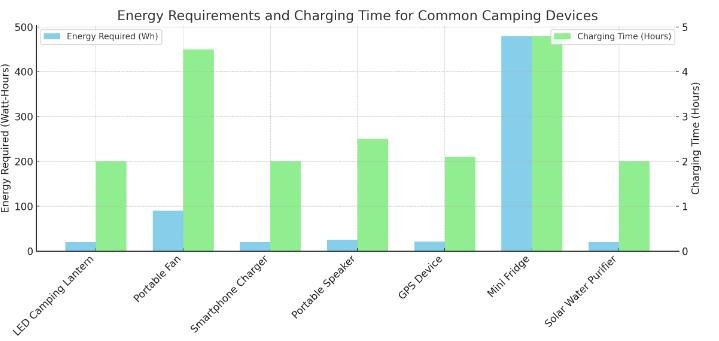
Listing Essential Devices and Their Power Consumption
Here are some common camping devices and their typical power consumption:
- Smartphone charger: 5-10W
- Laptop charger: 45-90W
- LED camp light: 1-5W
- Portable fan: 2-5W
- Mini fridge: 40-60W
- Electric cooler: 40-80W
- Portable speaker: 5-20W
- CPAP machine: 30-60W
Remember, these are estimates, and actual consumption may vary.
Factoring in Camping Duration and Weather Conditions
Consider these factors when assessing your power needs:
- Trip length: Longer trips may require larger battery storage or more efficient power management.
- Season: Winter camping often requires more power for heating devices.
- Location: Some areas receive more sunlight than others, affecting solar panel efficiency.
- Weather forecast: Plan for a few days of cloudy weather by including extra battery capacity.
Determining the Ideal System Size for Your Needs
To size your system:
- Take your daily energy requirement (in watt-hours).
- Add a 20% buffer for unexpected power needs.
- Divide by the number of peak sun hours in your camping location (typically 4-6 hours).
- The result is the minimum wattage your solar panel(s) should produce.
For example, if you need 500Wh per day and expect 5 peak sun hours: (500Wh x 1.2) / 5 hours = 120W solar panel capacity
Choosing the Right Solar Panel System
Now that you know your power requirements, it’s time to select the right solar panel system for your camping needs.
Portable vs. Fixed Solar Panel Options
- Portable solar panels:
- Pros: Flexible, easy to position for optimal sunlight, can be stored when not in use.
- Cons: Usually less powerful, may require frequent repositioning.
- Fixed solar panels:
- Pros: Higher wattage options, more durable, always ready to use.
- Cons: Less flexible, may require permanent installation on an RV or camper.

Monocrystalline vs. Polycrystalline Solar Panels
- Monocrystalline panels:
- Pros: Higher efficiency (20-22%), better performance in low light, sleek appearance.
- Cons: More expensive, slightly less durable.
- Polycrystalline panels:
- Pros: More affordable, slightly more durable.
- Cons: Lower efficiency (15-17%), larger size for equivalent power output.
Foldable vs. Rigid Panel Designs
- Foldable panels:
- Pros: Highly portable, easy to store and transport.
- Cons: Usually less powerful, potentially less durable.
- Rigid panels:
- Pros: More durable, often more powerful.
- Cons: Less portable, require more storage space.
Factors to Consider: Efficiency, Durability, and Weight
When choosing your solar panels, keep these factors in mind:
- Efficiency: Higher efficiency means more power from a smaller panel.
- Durability: Look for panels with sturdy construction and good warranties.
- Weight: Important for backpackers or those with weight restrictions.
- Size: Consider your available space for both use and storage.
- Price: Balance your budget with your power needs and quality expectations.
Essential Components for Your Campsite Solar Setup
Let’s dive deeper into the key components you’ll need for a complete campsite solar system.
Solar Panels: Types and Wattage Options
Common wattage options for camping solar panels include:
- 50W: Good for charging small devices
- 100W: Suitable for powering multiple devices or a small camper
- 200W and above: Ideal for RVs or larger power needs
- CLICK TO KNOW THE BEST TYPES OF SOLAR PANEL FOR YOUR CAMPSITE
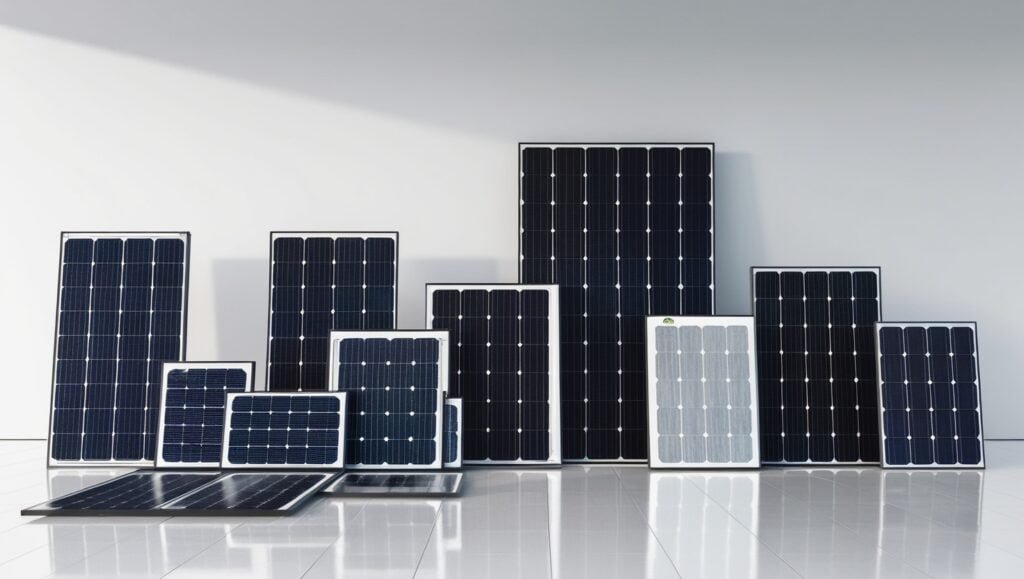
Charge Controllers: PWM vs. MPPT
- PWM (Pulse Width Modulation) controllers:
- Pros: Affordable, simple, good for small systems.
- Cons: Less efficient, especially with higher voltage panels.
- MPPT (Maximum Power Point Tracking) controllers:
- Pros: More efficient (up to 30% more than PWM), better for larger systems.
- Cons: More expensive, slightly more complex.
Deep Cycle Batteries: Lead-Acid vs. Lithium-Ion
- Lead-Acid batteries:
- Pros: Affordable, widely available.
- Cons: Heavy, shorter lifespan, sensitive to deep discharges.
- Lithium-Ion batteries:
- Pros: Lighter, longer lifespan, can be discharged more deeply.
- Cons: More expensive, may require special chargers.
Inverters: Modified Sine Wave vs. Pure Sine Wave
- Modified Sine Wave inverters:
- Pros: Less expensive, suitable for most devices.
- Cons: May cause issues with sensitive electronics or motors.
- Pure Sine Wave inverters:
- Pros: Compatible with all AC devices, more efficient.
- Cons: More expensive.
Cables, Connectors, and Mounting Hardware
Don’t overlook these important accessories:
- MC4 connectors for connecting solar panels, CLICK TO VIEW
- Anderson Powerpole connectors for batteries, CLICK TO VIEW
- Heavy-duty cables to minimize power loss, CLICK TO VIEW
- Mounting brackets or portable stands for solar panels, CLICK TO VIEW
Step-by-Step Guide On How to Set Up a Solar Panel System
Now that you have all the components, let’s walk through the setup process.
Selecting the Ideal Location for Your Solar Panels
- Choose a spot with maximum sun exposure throughout the day.
- Avoid shaded areas from trees or nearby structures.
- Consider the distance to your camping area for cable management.
- CLICK TO KNOW THE BEST WAY TO MAXIMZE EFFICIENCY OFSOLAR PANELS FOR OPTIMAL POSITIONING
Mounting and Angling Your Panels for Maximum Sun Exposure
- Use a compass to find true south (in the Northern Hemisphere) or true north (in the Southern Hemisphere).
- Tilt your panels at an angle equal to your latitude for optimal year-round performance.
- Consider adjustable mounts to change the angle seasonally or throughout the day.
click to check my post on solar lighting solutions for campsites

Connecting the Solar Panels to the Charge Controller
- Connect the positive (+) wire from the solar panel to the positive solar input on the charge controller.
- Connect the negative (-) wire from the solar panel to the negative solar input on the charge controller.
- Ensure all connections are secure and protected from the elements.
- Also know how to set up your solar panels systems
Wiring the Battery to the Charge Controller and Inverter
- Connect the positive terminal of the battery to the positive battery output on the charge controller.
- Connect the negative terminal of the battery to the negative battery output on the charge controller.
- If using an inverter, connect it directly to the battery terminals, using appropriate fuses.
Setting Up a Distribution Panel for Your Devices
- Install a distribution panel with multiple outlets and USB ports.
- Connect the distribution panel to the inverter output.
- Use appropriate fuses for each circuit to protect your devices.
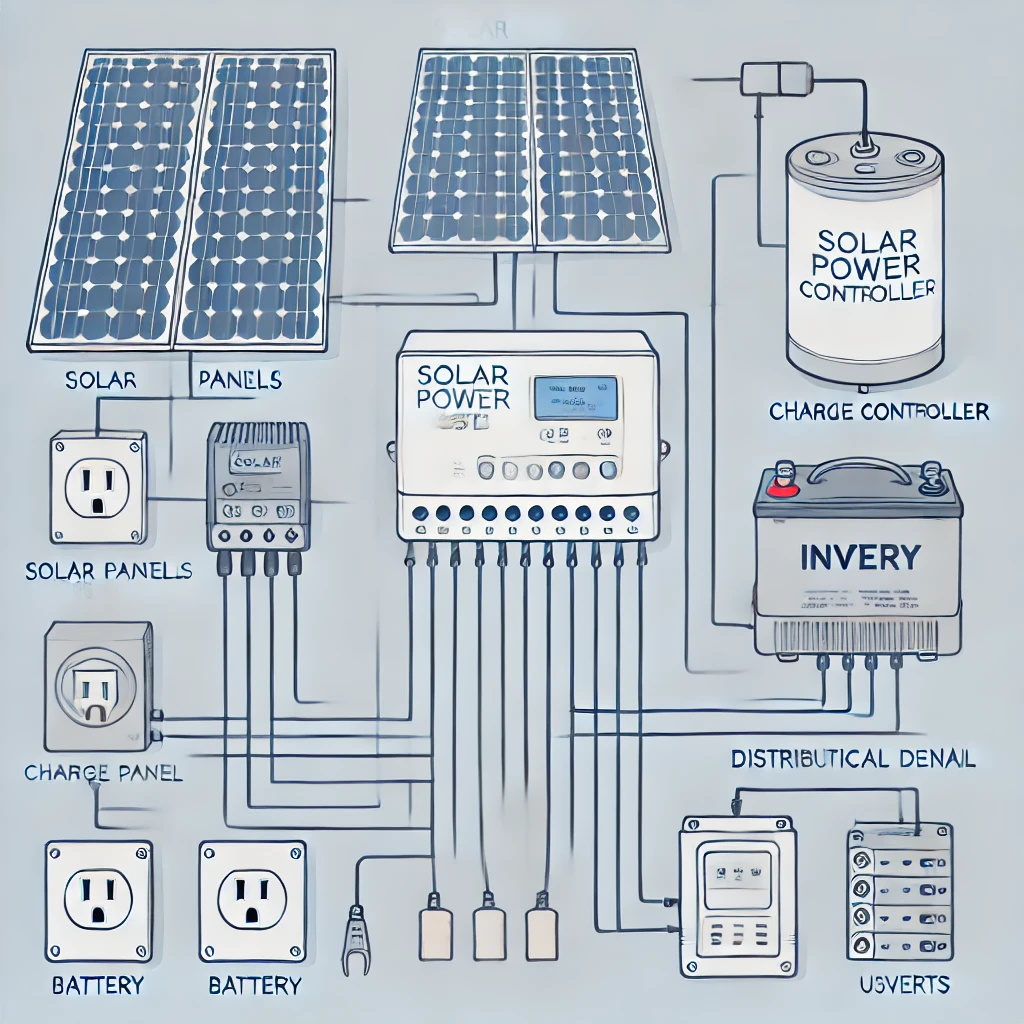
Maximizing Efficiency of Your Campsite Solar System
To get the most out of your solar setup, follow these tips and strategies.
Tips for Optimal Panel Placement and Sun Tracking
- Regularly clean your panels to remove dust and debris.
- Reposition portable panels throughout the day to follow the sun’s path. Check out blog post: optimal solar positioning guide
- Use a solar tracker app to find the best angle and orientation.
Managing Power Consumption and Prioritizing Devices
- Use energy-efficient devices whenever possible.
- Charge devices during peak sunlight hours.
- Prioritize essential devices when power is limited.
Using Energy-Efficient Camping Gear and LED Lighting
- Invest in LED lanterns and headlamps.
- Choose camping equipment with good energy ratings.
- Use insulated coolers to reduce the workload on electric coolers or fridges.
Implementing a Backup Power Strategy for Cloudy Days
- Bring a portable solar power bank for small devices. Click to view the top recommendations
- Consider a small gas or solar generator for emergencies. Click to know what generator suits you best
- Plan activities that require less power during periods of low solar production.
Maintaining and Troubleshooting Your Solar Setup
Proper maintenance and quick troubleshooting can keep your solar system running smoothly.
Cleaning and Caring for Your Solar Panels
- Use a soft brush and water to clean panels regularly.
- Inspect for any cracks or damage after each trip.
- Store panels in a protective case when not in use.
Monitoring Battery Health and Charge Levels
- Use a battery monitor to track charge levels.
- Avoid fully discharging lead-acid batteries.
- Perform periodic equalization charges on flooded lead-acid batteries.
Common Issues and Their Solutions
- Low power output: Check for shading or dirty panels.
- No power from inverter: Verify battery charge and connections.
- Slow charging: Ensure proper panel angle and clean surfaces.
When to Seek Professional Help
Consult a professional if you encounter:
- Electrical issues beyond your expertise.
- Physical damage to panels or other components.
- Persistent system underperformance.
Frequently Asked Questions (FAQ)
1. How much does a camping solar panel system cost?
The cost can range from $200 for a basic portable setup to $2000 or more for a comprehensive RV system. The price depends on the system size, component quality, and your power needs.
2. Can I use solar panels in winter or cloudy weather?
Yes, solar panels still work in winter and on cloudy days, albeit with reduced efficiency. Planning for these conditions by including extra battery capacity or energy-saving measures is advisable.
3. How long do camping solar panels last?
Quality solar panels can last 20-25 years or more, although their efficiency may decrease slightly over time. Other components like batteries and inverters typically have shorter lifespans of 5-10 years.
4. Do I need special skills to install a solar panel system for camping?
Basic DIY skills are usually sufficient for setting up a camping solar system. However, if you’re uncomfortable working with electrical systems, it’s best to consult a professional.
5. Can I use my home solar panels for camping?
While possible, home solar panels are often not designed for portability. It’s usually better to invest in panels specifically made for camping or outdoor use.
Click here to see the top outdoor solar panels for camping
Conclusion
There you have it, fellow campers – your complete guide to setting up a solar panel system for your campsite! With these tips and tricks, you’re all set to create your own eco-friendly power station in the great outdoors. No more worrying about dead batteries or noisy generators. Just clean, green energy to fuel your adventures.
Remember, the key is to start small and scale up as you get more comfortable with your solar setup. Click here to view the top outdoor solar gadgets you need for camping. So, are you ready to embrace the solar-powered camping revolution? Get out there, soak up some rays, and enjoy the perfect blend of nature and technology. Happy camping and happy solar powering!

Affiliate Disclosure
This site contains affiliate links. If you purchase through these links, I may earn a small commission, at no additional cost to you. I only recommend products I trust and think will benefit you.



